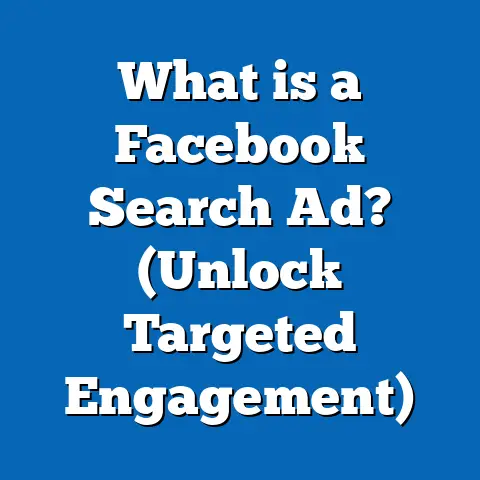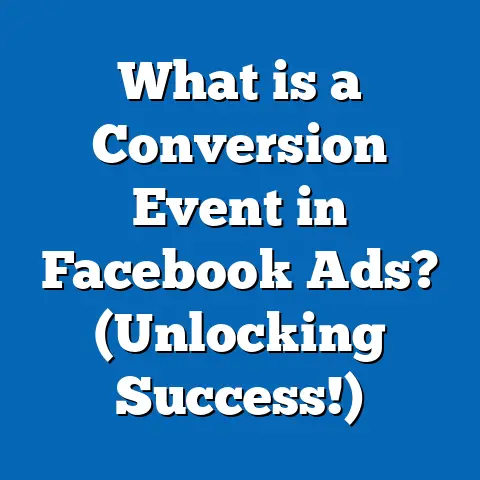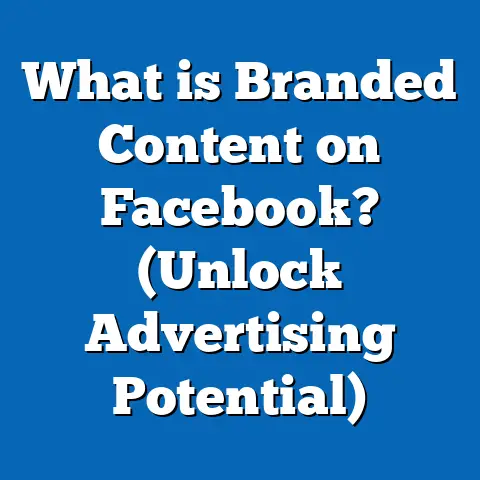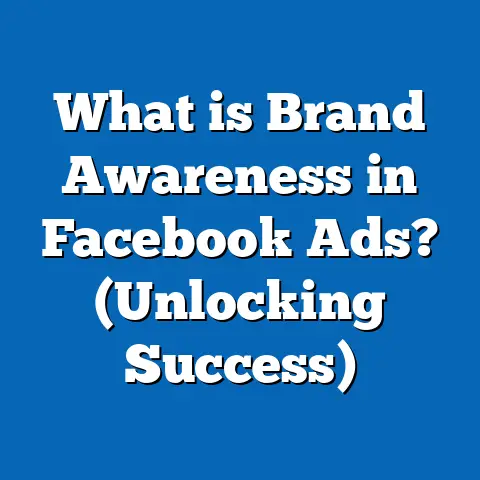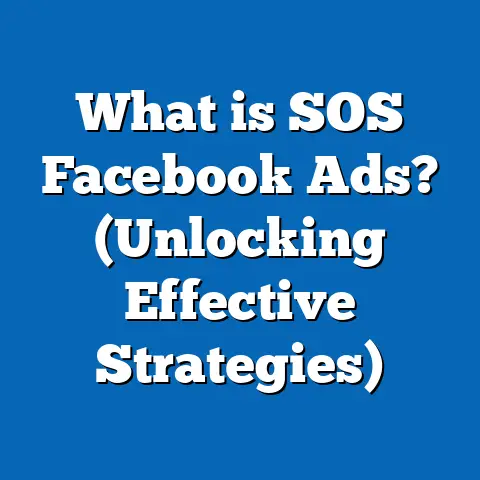What is the Ideal Audience Size for Facebook Ads? (Secrets Revealed)
Introduction:
Imagine you’re Sarah, the new marketing manager at a fast-growing e-commerce startup. Your boss wants aggressive growth, and Facebook Ads is your weapon of choice. You’ve set up campaigns before, but this time, you notice something odd: your audience size recommendations on Facebook keep changing. Should you target a tight niche of 5,000 people or cast a net over millions? Will a small audience limit your reach—or will a large one waste your budget? The stakes are high. Every dollar counts, and the wrong move could stunt your campaign’s performance. This is where understanding the ideal audience size for Facebook Ads becomes not just useful, but essential.
Why Audience Size Matters in Facebook Advertising
The Core Function of Audience Size
Audience size directly impacts how your ads perform. It shapes your CPM (cost per thousand impressions), CPC (cost per click), and conversion rates. Too small an audience means your ads might fatigue quickly, leading to higher costs. Too large, and you risk wasted impressions and diluted relevance.
The Facebook Algorithm and Audience Size
Facebook’s algorithm thrives when it has data to work with. A well-sized audience gives the system enough users to test, learn, and optimize delivery for your objectives—whether that’s clicks, conversions, or video views.
- Stat: According to Facebook Business, campaigns with “learning-limited” status due to small audiences can see up to 20% higher CPA (cost per action).
Understanding Facebook’s Audience Recommendations
What Facebook Recommends
Facebook typically suggests audiences ranging from 500,000 to 2 million for broad campaigns (like Traffic or Awareness) and 100,000 to 500,000 for more conversion-focused campaigns (like Purchases).
- For retargeting or highly specific offers, audiences can be as small as 1,000-10,000.
Data Point
A 2023 study by AdEspresso analyzed 3,100 campaigns and found:
- Audiences under 10,000 saw a 32% higher CPM.
- Audiences over 10 million saw a 21% lower CTR (click-through rate) compared to mid-sized audiences.
The Science Behind Audience Size: How It Impacts Performance
Ad Fatigue and Frequency
Smaller audiences are more likely to see the same ad repeatedly. Ad fatigue sets in faster, driving up costs and lowering engagement.
- Example: An audience of 8,000 for a daily spend of $100 can see ad frequency reach 5+ in just a week—resulting in plummeting CTRs and rising costs.
Algorithmic Learning and Optimization
The algorithm needs about 50 conversions per ad set per week to exit the learning phase. Small audiences may not generate enough events for this optimization.
- Meta Research: Campaigns that complete learning phase see up to 30% lower CPA.
Budget Allocation and Delivery
Large audiences allow for smoother budget allocation. If your audience is too small, Facebook may struggle to spend your budget efficiently.
Ideal Audience Sizes by Campaign Objective
Awareness Campaigns
- Recommended Size: 1 million – 10 million+
- Why: Broad targeting helps maximize impressions at lowest CPM; perfect for new product launches or branding initiatives.
Consideration Campaigns (Traffic, Engagement)
- Recommended Size: 500,000 – 2 million
- Why: Sizable enough for machine learning but narrow enough for relevance.
Conversion Campaigns (Leads, Sales)
- Recommended Size: 100,000 – 500,000
- Why: Focus on users most likely to convert; allows for sufficient conversions without diluting spend.
Retargeting Campaigns
- Recommended Size: 1,000 – 50,000
- Why: These are your warmest leads; smaller pools are effective but watch frequency closely.
Case Studies: Real-World Lessons on Audience Size
Case Study 1: E-commerce Brand Scaling Conversions
A DTC apparel company tested three audience sizes for a conversion campaign:
| Audience Size | CPA | ROAS | Frequency |
|---|---|---|---|
| 15,000 | $17.80 | 2.1x | 4.9 |
| 200,000 | $10.90 | 3.6x | 2.3 |
| 2 million | $13.20 | 2.4x | 1.6 |
Takeaway: The mid-sized audience ($200K) delivered the best balance of cost and return.
Case Study 2: SaaS Lead Generation
A SaaS startup used a $50 daily budget to target:
- A lookalike audience of 1%, size: 300,000
- A broader interest-based audience: 1.5 million
Results:
Technical Deep Dive: How Facebook Defines and Calculates Audience Size
Overlapping Audiences
If you run multiple ad sets with overlapping audiences, Facebook will split impressions—potentially driving up costs and causing auction inefficiency.
Estimated Reach vs Actual Delivery
Facebook’s estimated reach is just that—an estimate. Actual delivery depends on:
- Budget
- Bid strategy
- Competition in auction
Pro Insight: Always monitor actual reach and frequency metrics after launch.
Factors Influencing Ideal Audience Size
1. Budget
Larger budgets require larger audiences to avoid saturation and inflated costs.
- Rule of Thumb: For every $10/day in spend, aim for at least 10,000 people in your audience (except retargeting).
2. Objective
Brand awareness needs scale; conversions demand focus.
3. Creative Fatigue
If creative is limited (few ad variations), opt for larger audiences to delay fatigue.
4. Market Size
Niche products or services may inherently have smaller potential audiences—focus on segmentation and creative rotation in these cases.
Best Practices: Building the Right-Sized Audience
Start Broad—Then Narrow Down
Begin with broader targeting (interests/lookalikes), then use breakdowns to identify top-performing segments.
Use Lookalike Audiences Effectively
A 1%-2% lookalike is often around several hundred thousand users—a sweet spot for conversion campaigns.
- Combine with interest layering for balance between quality and scale.
Frequent Audience Refreshes
Rotate creatives or expand custom audiences before frequency exceeds 2x per week.
Monitor Metrics Closely
Key metrics to watch:
- Frequency
- CPM
- CPA
- ROAS
If frequency climbs while results dip, expand your audience or refresh ads.
Comparing Facebook Audience Sizing with Other Platforms
| Platform | Recommended Cold Audience Size | Notes |
|---|---|---|
| Facebook/Meta | 100K – 2M+ | Most flexible algorithm |
| Google Ads | 10K – unlimited | Keyword intent trumps audience size |
| 100K – 400K | Smaller B2B pool; more expensive CPMs | |
| TikTok | >500K | Broad targeting recommended |
Summary: Facebook/Meta offers more flexibility with audience size compared to LinkedIn (where inventory is smaller and more expensive) or Google (where intent takes priority).
Advanced Tactics: Secrets from Top Advertisers
Use Broad Targeting + CBO (Campaign Budget Optimization)
Letting Facebook’s AI optimize across large audiences with CBO often yields better results than micromanaging small ad sets.
- Stat: Meta reports advertisers using CBO with large audiences saw up to 21% higher ROAS vs manual ad set budgets (2022).
Stack Custom Audiences for Scale
Combine website visitors + email list + social engagers into a single custom audience for maximum retargeting power.
Exclude Recent Converters
Avoid wasting budget by excluding those who have already converted in the last X days—especially important in smaller or retargeting pools.
Split-Test Audience Sizes Regularly
Test different sizes head-to-head: e.g., one ad set with a narrow lookalike vs one with a broader interest pool—let data decide the winner.
Key Data & Industry Statistics
- Meta recommends at least 10x your daily budget in audience size (e.g., $20/day = 200K audience).
- AdEspresso: Audiences under 10K see 32% higher CPM and faster fatigue.
- WordStream: Accounts with audiences <50K had average CTRs of just 0.39%, compared to 1.05% for those at 250K+.
- Meta internal data: Ad sets completing learning phase reduce CPA by 30% on average.
Myths & Misconceptions About Facebook Ad Audience Size
Myth #1: Smaller Is Always Better
Reality: Micro-targeted audiences limit scale and drive up costs due to rapid fatigue and limited learning data.
Myth #2: The Bigger the Better
Reality: Massive audiences can dilute relevance; Facebook may show ads to users unlikely to convert if you don’t layer interests or behaviors.
Myth #3: You Can Ignore Overlap
Reality: High overlap between ad sets splits impressions, hurting efficiency.
Practical Implementation Steps: How to Find Your Ideal Audience Size
- Define Your Objective: Awareness? Traffic? Conversions?
- Estimate Your Budget: Match budget to recommended minimum audience size.
- Build Initial Audience Pool: Use interests, lookalikes, demographics.
- Layer & Exclude: Stack interests/behaviors; exclude recent converters or irrelevant segments.
- Launch & Monitor: Watch frequency, CPM, CPA within first week.
- Optimize: Expand or contract based on performance data; refresh creatives as needed.
- Rinse & Repeat: Continually test new sizes as you scale.
Case Example: Scaling from Niche to National
A local fitness studio started with a custom audience of website visitors (<del>8K). Results were strong but quickly fatigued (frequency >4 in two weeks). Expanding to a lookalike of past purchasers (</del>120K) dropped frequency and improved CPA by 27%. Eventually layering in broad interests (~600K) allowed them to scale spend while maintaining steady returns.
Staying Ahead: Industry Trends & What’s Next for Audience Targeting on Facebook
- Meta is moving towards more automated targeting (“Advantage+” placements/audiences).
- Privacy changes (iOS14+) have shrunk custom audience pools—making size even more crucial.
- Creative differentiation matters more as automation increases; larger audiences give algorithms more room to optimize.
Conclusion & Actionable Takeaways
Finding the ideal audience size for Facebook Ads isn’t about picking an arbitrary number—it’s about matching your campaign objective, budget, and creative strategy with the right-sized pool of people.
Key takeaways:
- For cold prospecting: start with at least 100K–500K; scale upwards based on results.
- For retargeting: pools can be much smaller (1K–50K) but watch frequency.
- Always match audience size to your daily budget (minimum ratio: 10x).
- Monitor performance metrics closely—adjust size as soon as you see signs of fatigue or inefficiency.
- Regularly test new audience combinations; let the data guide your scaling decisions.
- Don’t fear broad targeting—when paired with good creative and CBO, it can outperform micro-niches.
Whether you’re Sarah at the e-commerce startup or a seasoned media buyer managing millions in spend, understanding how—and when—to adjust your Facebook ad audience size is one of the most powerful levers you can pull for better results.
For further learning:
Experiment with split-testing different audience sizes in your next campaign cycle. Document outcomes carefully—every brand’s “sweet spot” is unique!
If you’d like templates or advanced troubleshooting guides on Facebook Ads optimization, let me know!

